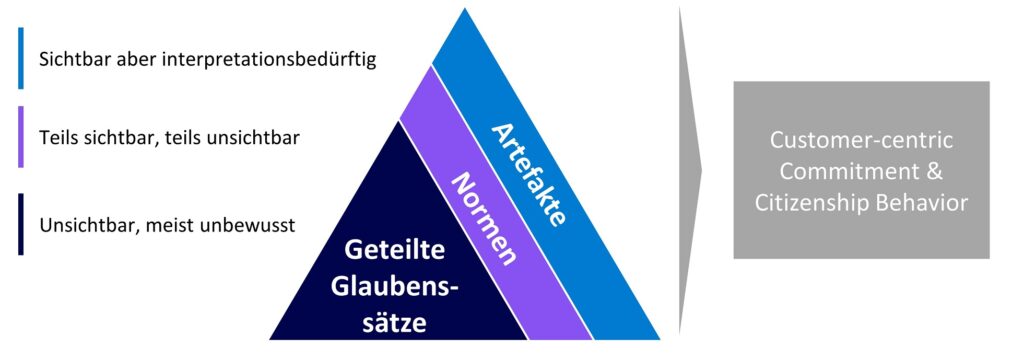Customer orientation is now often reduced to culture. All it takes is a customer-centric culture and then the issue of customer orientation virtually flies by itself. It’s not that simple. But culture does have an impact or is an important element in strengthening customer focus. A customer-centric culture generally encompasses three dimensions:
- Shared common beliefs
- Standards
- Artifacts

These have an influence on the attitude (customer-centric commitment) and behavior (customer-centric citizenship behavior) of the employees. The basis of a culture comes from its genetics, the shared common beliefs. These shared beliefs need to be identified and analyzed for compatibility to increase customer focus. Customer centricity puts people at the center of all activities. This idea should be shared within the organization in order to be able to continuously improve customer orientation. In addition, decisions should be made in the organization based on customer insights. The continuous pursuit of learning is also an important belief. Thus, beliefs, as opposed to norms, are general but supportive of an organization’s customer centricity. Since beliefs tend to be general in nature, the challenge at this point is to create a list of beliefs that support a customer-centric culture.
The norms of an organization are built on the shared beliefs. Standards are an important part of defining a customer-centric culture. In contrast to rules and control, norms give individuals more freedom to achieve goals, but also more responsibility to interpret them in terms of intent. Standards have a guiding function for goal-oriented action.
Norms describe the behaviour that the members of an organization enforce each other
to follow.
Accordingly, norms are explicit or implicit rules about desired or undesired behaviors in organizations. Unclear or conflicting standards can get in the way of improving customer focus. Central standards of customer centricity are:
- Targets based not on data, but on customer insights.
- If possible, don’t make a decision without customer insight.
- Systematically improve the decision-making processes
- Transform the organization to better respond to change.
- Engage the customer wherever value can be enhanced for both parties.
- Prevent silo thinking in the organization.
- Also, mission your network in terms of customer focus.
- Systematically increase the value for both the organization and the customers.
Standards easily lead to every single standard being written down and communicated to
. The level of bureaucracy in an organization is expressed not only in the
depth of hierarchy but also in the level of specialization, regulation and documentation. It is not enough to force customer orientation into the organization by means of rules and communication. As well-intentioned as the mission statements on the walls are, they cannot be experienced. That is why standards must never stand alone. It is important to make them tangible for all employees, since standards are always subject to a subjective assessment by each individual.
Therefore, artifacts are another component of a customer-centric culture. Artifacts make the standards tangible for the employees of an organization. The acquisition and interpretation of artifacts place great demands on individuals. It is necessary to distinguish four different artifacts of an organization:
- Stories
- Arrangements
- Rituals
- Language
These four artifacts have not been systematically studied to date. Most importantly, there is little awareness that these four artifacts are interconnected. In doing so, the artifacts can have a much greater impact than other instruments. Stories are now deliberately used in practice under the fashionable term storytelling. In doing so, stories can be based on improving the customer centricity of one’s own or another’s organization. But beware: Apple, Google, Amazon and AirBnB stories wear out over time and are unreachable galaxies for the vast majority of employees. Sharing dreams is fundamentally an important element for motivation, but most organizations only have a pedal scooter and not a rocket available for their journey to better customer focus. It literally brings tears to one’s eyes when Swiss retailers compare themselves to Amazon, with the market potential in one case being over five billion and in the other a little over eight million. Thus, it is important to spread stories about one’s own successes or those of competitors concisely throughout the organization.
Along with stories, arrangements in organizations likewise have an impact on customer-centric culture. Arrangements in this context are to be understood as physical manifestations. Examples include expensive furniture in the waiting room, a coffee vending machine that produces high-quality coffee, or customer interaction rooms that demonstrate, due to the generosity and high quality of the materials used, “Our customers are important to us.” Arrangements are not to be understood as customer experience or the demand for unnecessarily expensive design elements at customer touch points. It is about elements within an organization that demonstrate to every employee that the organization’s customers are important. Thus, the many posters written all over office corridors on the subject of customer orientation are also not to be seen as arrangements, because they only describe that customer orientation is important, but do not represent it themselves.
Rituals are another artifact of a customer-centric culture. Different rituals can be used to improve customer centricity. Thereby e.g. customer events or the annual determination of the most customer-centric employee.
The final artifact to consider is the language of an organization. How often have we seen in recent years that the word “customer” was not even mentioned in meetings and workshops? How often have executives in workshops repeatedly referred to costs instead of possible growth potential? The language and with what frequency certain terms are used has a major impact on the development of a customer-centric culture. It is closely connected with the rituals. Rituals can help change the language in an organization over time. Some organizations provide new employees with a glossary of key terms when they are hired. Even if we are aware of the longing for simple and clear rules – sorry, these do not exist and certainly not in terms of culture. Each organization and each manager must decide for themselves which elements are purposeful and to what extent they help to improve customer centricity. In general, we recommend starting with language, as it affects everyone, is easy to change, and makes a big difference
We wish you every success in establishing a customer-centric culture.





